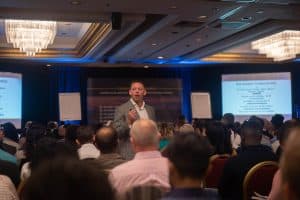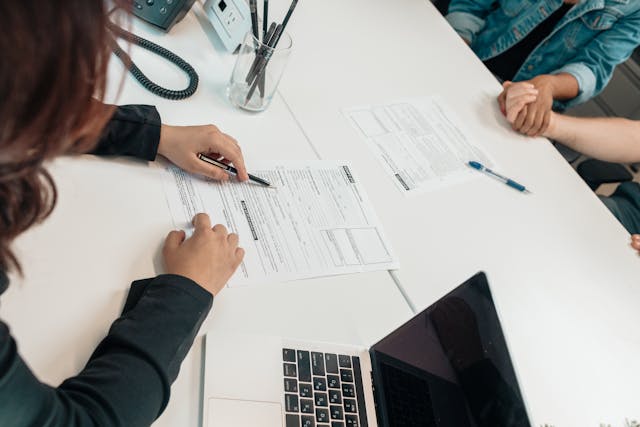
Best Property Investment Courses in the UK
Discover top-rated UK property investment events, bootcamps, and mentors, including Martin Roberts, Stuart and Scarlette

Many owners of leasehold properties consider converting their type of ownership from a leasehold to a freehold; there are many benefits to doing so. But how does this work? What steps do you have to take to convert your leasehold into a freehold? I will provide you with all the information you need, from eligibility and costs to timelines and more.
Table of Contents
ToggleFirst, let’s clarify the definitions of leasehold and freehold properties. A leasehold property is one where you own the house itself, but not the land that it is built on – this is common for flats and apartment buildings, not as much for houses, although some houses are leaseholds. The freeholder will own the land that the property is on and often the surrounding outdoor spaces like gardens – these spaces are the responsibility of the freeholder to maintain. A freehold property is one where you own the house and the land it stands on, usually including any outdoor space like yards, driveways and gardens. Freeholders can charge ground rent to the property owners, often in exchange for maintaining communal areas.
Converting a property from a leasehold to a freehold is beneficial for the owner, as you no longer have to pay any ground rent, it’s easier to get a mortgage on the property or to sell it, freehold properties have a higher resale value than leaseholds, and you can make any changes to the property without having to get permission from the freeholder.
Converting a property from a leasehold to a freehold is a legal process which involves buying the freehold from the owner. You will need to employ a solicitor or conveyancer to facilitate this process. Thanks to the Leasehold and Freehold Reform Act 2024, it’s much easier to buy a freehold than it used to be. Before the Act, homeowners used to have to wait at least 2 years to buy their freehold after purchasing the property, and now there is no waiting period. The Act makes it easier for several leaseholders in blocks of flats to get together and purchase the freehold collectively, giving them more control over their building and stopping freeholders from charging excessive ground rent or service charges. Owners can also extend their leasehold for up to 990 years, making it easier to sell leasehold properties. The Act also removes the requirement to pay ‘marriage value’, an additional cost incurred when extending leases with less than 80 years remaining. Also, leaseholders are no longer obligated to cover the freeholder’s legal costs when exercising their rights to extend a lease or buy the freehold.
Firstly, you need to get a freehold survey or property valuation from RICS or other qualified surveyors. You need to get a value for the freehold premium, i.e. your offer to the freeholder, before approaching them. Surveyors may also help you to negotiate the freehold price with the freeholder, provide ongoing advice, or attend follow-up meetings or site visits, for an additional fee.
You can now approach the freeholder with your intention to buy the freehold. You can do this informally by just asking them – they may well accept. The formal process begins by serving the freeholder with a Section 13 notice under the Leasehold Reform, Housing and Urban Development Act 1993. They may accept the offer or negotiate for a better price. Your solicitor or conveyancer can help with negotiation. The freeholder has two months to respond to your notice. If they refuse outright, you can appeal through a first-tier tribunal, and if that fails, apply to the county court to buy the freehold.
Yes, but only in certain circumstances. A freeholder can refuse to sell if the building is mixed use and contains more than 25% non-residential space, if the building contains several flats or apartments and 50% or more of the owners don’t want to buy the lease, or if the correct legal process is not followed, i.e. there are errors in the notice served by the leaseholder. Some types of property are also exempt, such as Crown-owned properties, those owned by charitable housing trusts, National Trust housing or military housing. If the freeholder refuses to sell the freehold to a leaseholder and the case reaches tribunal or county court, then it still may get rejected, if the court believes the leaseholder is acting in bad faith, i.e. using collective enfranchisement to disrupt other leaseholders or for other ulterior movies, although this is very hard to prove.
The costs of converting a leasehold to a freehold can vary depending on the size of the property and legal costs. For example, a property worth £292,000 with £366 annual ground rent payments would cost around £8,500 to buy the freehold. You should also factor in other costs such as surveyor fees and legal fees including transfer of ownership with HM Land Registry, bank transfer fees and other admin costs.
Like many property sales and legal processes, it may take some time for the sale of a freehold to complete. If the offer to buy the leasehold is accepted right away, all parties are cooperative and there are no issues along the way, the whole process can be completed within a few weeks. If the leasehold is for a block of flats, it can take a long time to get all leaseholders on board with the sale. In this case, or if the freeholder refuses to accept the offer or doesn’t want to sell at all, it can take over 12 months to complete the sale of a freehold. As always, maintaining good levels of communication and keeping up with finances and paperwork can help this process run more smoothly.
Find out more about the exciting world of property investment and gain valuable insights from experts with one of Assets For Life’s FREE property events – sign up or learn more by clicking the link below.
You May Also Be Interested In...

Best Property Investment Courses in the UK
Discover top-rated UK property investment events, bootcamps, and mentors, including Martin Roberts, Stuart and Scarlette

How to Make a Million Pounds from Property Investing
Discover how to earn £1 million through UK property investing with practical strategies and expert

How To Grow A Property Portfolio – Free Online Training
Grow your UK property portfolio from scratch with expert tips, creative strategies and free online
Featured Property Investment Events & Courses
The Property Deal Packaging Summit
The Property Millionaire Bootcamp
The Serviced Accommodation Bootcamp
Assets For Life LTD is a company incorporated in England and Wales with registered number 09935286 and registered offices at Assets for Life Ltd, Suite 105, Waterhouse Business Centre, 2 Cromar Way, Chelmsford, Essex, England, CM1 2QE, United Kingdom.
Assets For Life LTD is registered with the Information Commissioner’s Office, with registration number ZA280607
COPYRIGHT © 2024 ASSETS FOR LIFE, ALL RIGHTS RESERVED. WEBSITE BY AMPLIFY MARKETING